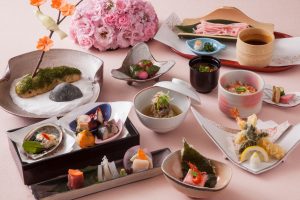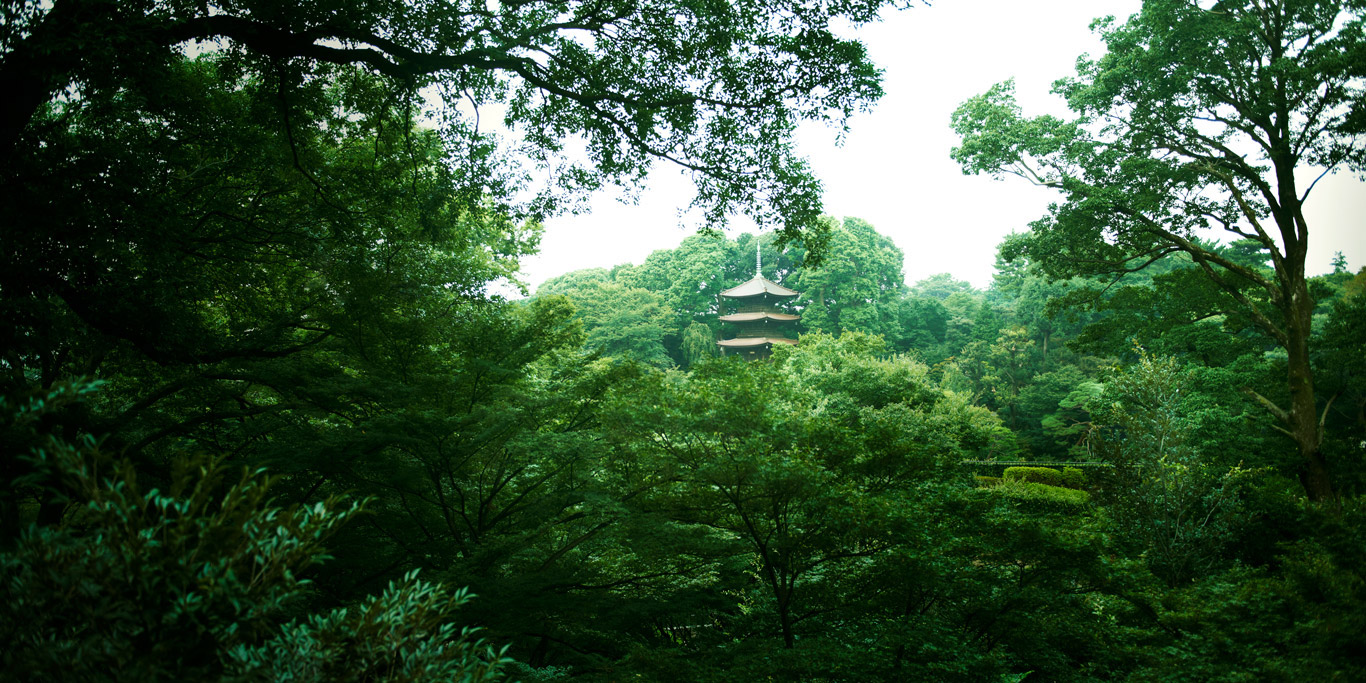
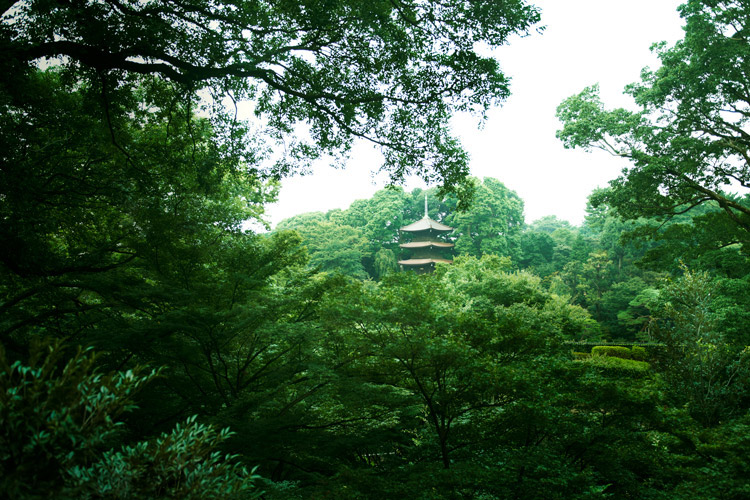
Gardens
What's new
Enjoy the Seasons and Refined Japanese Cuisine at Hotel Chinzanso Tokyo
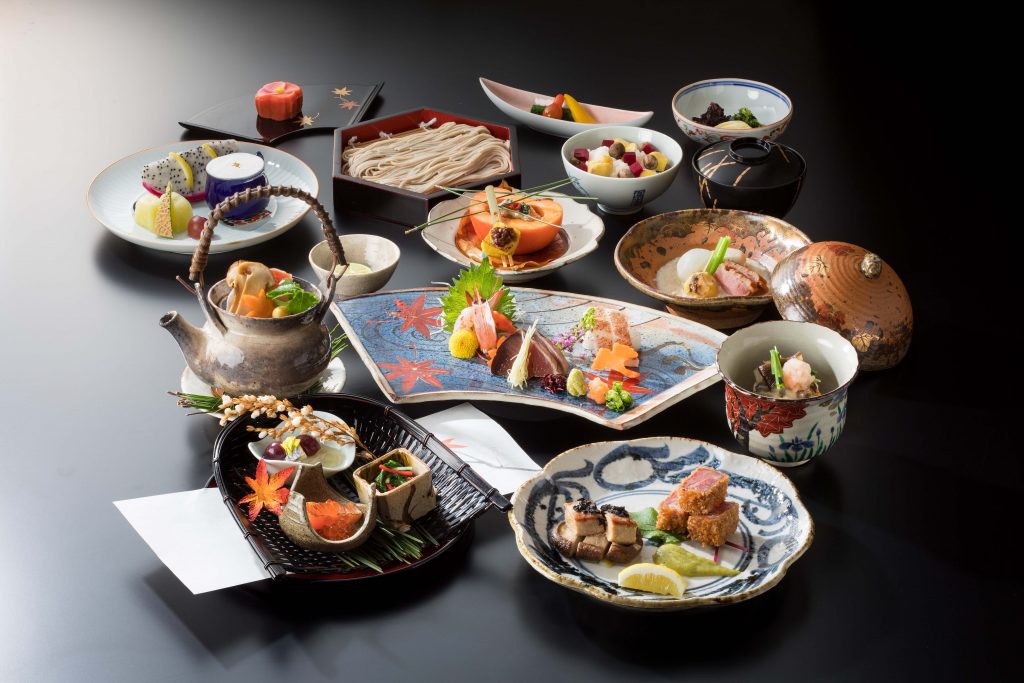
If we think of culture as the result of humanity’s interaction with nature, Japan is a place where the deep connection between nature and culture can be observed on a daily basis. The cuisine, the fashion and clothing, or the interior decoration of homes and public spaces, always reflect the features of the current season. This sensitivity toward the four seasons is so deeply ingrained in Japanese lifestyles that every discourse about food, for instance, will necessarily bring into discussion the current season.
In order to truly appreciate Japanese cuisine, it is important to be aware of the features of the natural scenery. The color of the foliage, the flowers that are in bloom, the vegetables, fruit, and seafood that are in season, the sounds of the wind, the birds and the insects, the colors of the sky–all these change with each season, and these changes are reflected directly in the dishes that people enjoy at that time of the year.
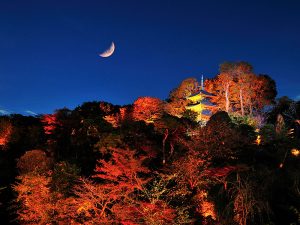
If you wish to observe and experience nature in Tokyo and also enjoy exquisite cuisine that reflects the current season, visit Hotel Chinzanso Tokyo. The beautiful Chinzanso Garden, which spreads like a green oasis in the heart of the city, is one of the few places in the metropolis with vast natural scenery that changes with the seasons. The hotel boasts some of the best restaurants in Tokyo, offering both Japanese and Western cuisine. The restaurants within the hotel can be visited by hotel guests and non-hotel guests. Moreover, the staff at each one will carefully explain the features of each dish, for the guests to fully enjoy their Japanese dining experience.
Experience the Seasons: Japanese Kaiseki Cuisine at Hotel Chinzanso Tokyo
After arriving at Hotel Chinzanso Tokyo, we suggest you first take a walk in the garden. Observe the colors of the foliage and the flowers that are in bloom. There is a high chance you will find the same colors and shapes on the table when dining at one of the hotel restaurants.
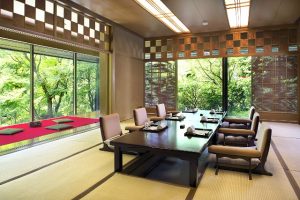
To enjoy the best of what the current season has to offer in terms of flavors, ingredients, and presentation, we suggest choosing a kaiseki meal course at Ryotei Kinsui or at the Japanese restaurant Miyuki. Kaiseki cuisine consists of a series of individual dishes prepared using seasonal ingredients. Both the flavors and the appearance of kaiseki cuisine reflect the seasons, as well as the features of the place where the restaurant is located. In the case of Kinsui, Miyuki and the other restaurants within Hotel Chinzanso Tokyo, the “location” is none other than the Camellia Mountain of Chinzanso Garden, that is why the plates and vessels may have details or patterns with a design of camellias.
Let us introduce a few points to keep in mind in order to fully appreciate kaiseki cuisine.
1.Emphasis lies on seasonal ingredients
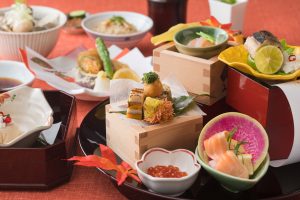
Offering guests dishes prepared with “foodstuff that is in season” (“shun no mono”) is a core principle of Japanese hospitality. In Japanese tradition, it is considered auspicious to synchronize one’s lifestyle to the pace of the seasons and to incorporate in one’s meals what the season has to offer. This belief is confirmed by nutritional studies that show that the nutritional content of vegetables, fruit, and seafood is at its highest when those ingredients are in season.
In early spring, kaiseki dishes will almost surely include bamboo shoots, because they taste best at this time of the year. Summer brings to the table fresh vegetables like green soybeans (edamame), asparagus, and okra, as well as fish like freshwater trout. Autumn coincides with the harvest season, offering an immense diversity of delicious foodstuff; some of the most popular autumn ingredients are mushrooms, pumpkin, chestnuts, and sweet potatoes. Winter is the season when seafood such as crab and shrimp are at their most flavorful.
2.Preserving the original flavors
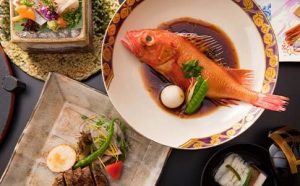
In kaiseki cuisine, the ingredients will never be overcooked. The point of kaiseki is to fully enjoy the original flavors and nutritional value of seasonal ingredients. That is why all the dishes are cooked in a way that allows guests to enjoy flavors and textures that are as close as possible to the natural state of the ingredients, while tasting delicious.
3.The meals are visually appealing
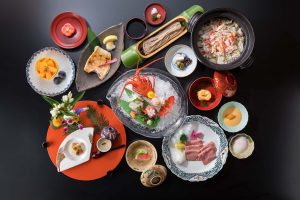
A kaiseki meal is to be enjoyed with one’s eyes as well as with one’s palate. Please take the time to observe the colors and shapes of each dish, jewellike creations that reveal features of the current season.
In spring, some of the side dishes or the dessert will probably be shaped as sakura cherry blossoms. In the summer, when it’s hot outside, the meal course will most likely be served on plates of blue color with patterns of flowing water, which inspire the feeling of coolness. In autumn, the vibrant reds, oranges, and yellows of the foliage will also be found on your plate. Winter is the season when the camellias bloom, so expect to see camellia-shaped dishes or vessels.
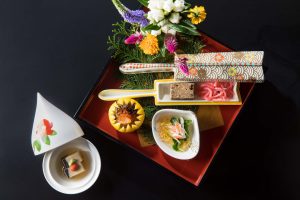
The vessels and plates the dishes are served in also play an essential role in the presentation. In Japanese cuisine, rather than having several dishes on the same plate, each dish is served in a small container. A kaiseki meal course is a chance to marvel at an impressive variety of shapes, colors, and designs when it comes to dishware. The containers, too, reflect the seasons through their shapes and colors, which implies that they are intended specifically for use during one season. In other words, you won’t find dishes or vessels with autumn leaf motifs in a spring kaiseki meal course.
4.Seven seasons at Hotel Chinzanso Tokyo
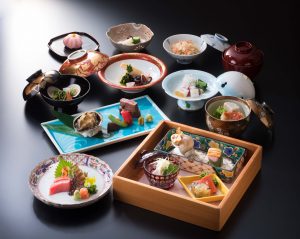
We commonly think of the seasons as four–spring, summer, autumn, and winter–but in Japanese tradition, all the transitional phases within the four seasons also have a name. The traditional Japanese calendar has twenty four seasons, each with its own features and specific ingredients.
At Hotel Chinzanso Tokyo, guests and restaurant patrons can enjoy the features of seven seasons through specific limited-time only kaiseki meal courses. Those seven seasons are: the season when camellias are in bloom (December – February), cherry blossom season (March – April), the season of fresh greenery (May), the season of the fireflies (June), summer (July), the season of deep green leaves (August), and autumn (September – November).
Ryotei Kinsui and the Japanese restaurant Miyuki offer dining courses that reflect these seasons and menus inspired by the seasons can also be enjoyed at Il Teatro, the main restaurant of the hotel specialized in Italian cuisine, as well as at the lobby lounge Le Jardin, which offers a different afternoon tea menu each season.
Seasonal Kaiseki Cuisine at Hotel Chinzanso Tokyo

Whatever the season you visit, you can enjoy exquisite kaiseki cuisine at Hotel Chinzanso Tokyo. The picture above is a Hanami Kaiseki course offered at the Japanese restaurant Miyuki. “Hanami” refers to the custom of viewing the cherry blossoms while enjoying a picnic right under the sakura trees in full bloom. The light pink color of some of the dishes and plates inspires the festive atmosphere of spring.
This type of menu is usually available from February until early April. If you go out for a walk in Chinzanso Garden during this period, you’ll notice the same colors adorning the trees. The course includes refined dishes made with fresh spring vegetables and young Spanish mackerel, sablefish, and octopus.
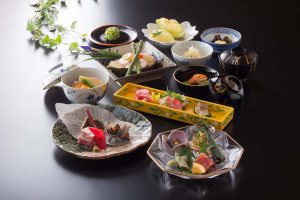
Visit in May or early June and you’ll be able to enjoy the season of fresh maple leaves (wakakaede). At this time of the year, the greenery is at its most vibrant in Chinzanso Garden. Pictured above is Wakakaede Kaiseki, also offered at Miyuki. Notice the green adorning almost every dish in a celebration of nature’s revival, as well as irises, the elegant flowers of early summer. The course features dishes with asparagus and edamame (green soybeans), which are in season at that time of the year.

Autumn-inspired menus like the Autumn Flavors Kaiseki pictured above are available from late September until early November. This is the time when maple leaves turn to bright red and orange bringing a splash of warm colors onto the table. Pumpkin, mushrooms and potatoes are in season; their rich flavors are featured in exquisite dishes that are a joy for the palate and the eyes.

From January until mid-February, guests can enjoy courses inspired by the New Year festivities. Pictured above is the Akebono Tsubaki Kaiseki course offered at Ryotei Kinsui in the first month of 2021. Akebono is the name of a type of camellia with large beautiful blossoms and light pink petals. Camellias bloom in the winter and are considered auspicious flowers; that is why it is customary to incorporate camellias in New Year cuisine or decorations. The guests who come to Hotel Chinzanso Tokyo at this time of the year are lucky to be visiting one of the best places in the city to relish the camellias.
This course features soba noodles, eaten at New Year’s as they are associated with longevity on account of their length. Other main ingredients are crab, Ise shrimp, and pufferfish, which are all in season and at the peak of their flavorfulness.
How about starting the New Year with a refined kaiseki course at Hotel Chinzanso Tokyo?
*Please note that the menus mentioned above have been introduced for illustration purposes , as examples of kaiseki cuisine offered at Hotel Chinzanso Tokyo. These menus have been or will be available for a limited period of time as announced on the official website of the hotel. Seasonal menus change every year.
Feel the Seasons through Sweets and Casual Cuisine
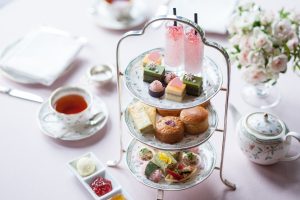
Kaiseki cuisine incorporates seasonal elements by definition, but any meal or dish, originally Japanese or not, can reflect the features of the seasons. For example, lobby lounge Le Jardin is well-known for its seasonal afternoon tea menus. Pictured above is the Sakura Afternoon Tea menu offered in 2018. The menu consists of several types of sweets and savory dishes with colors and flavors inspired by the cherry blossom season.
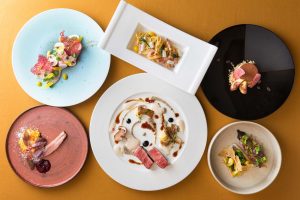
Another example is Cielo Autunnale – Autumn Sky, a menu offered at Il Teatro until November 30, 2020. It includes grilled Wagyu beef, as well as mushrooms, eggplant, and other vegetables in season. The light blue and rusty reds of the plates are hues that you can find in the garden at this time of the year, enhanced by the sea of clouds, a new feature that was added to the garden this year in October.
Enjoy the Seasons through Exquisite Cuisine
Japanese cuisine is a mirror to the seasons. A deeper understanding of nature’s rhythm is a prerequisite for fully enjoying Japanese cuisine. In the garden of Hotel Chinzanso Tokyo, you will find all the trees and flowers that represent the seasons in Japanese culture. It is the ideal environment to carefully observe nature and then enjoy cuisine that reflects the colors and flavors of the season.

